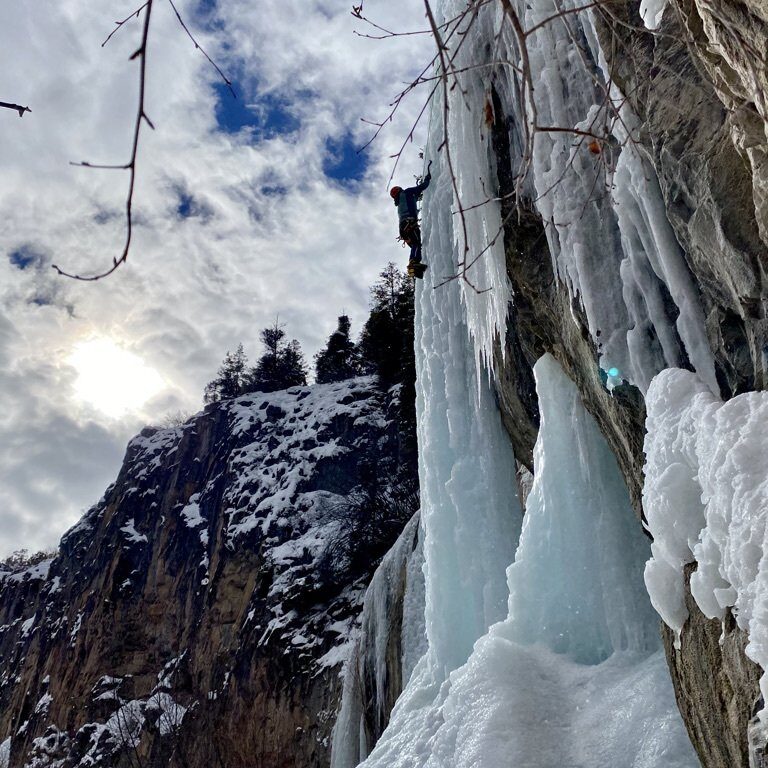When I first started venturing into longer winter climbing days, packing for multi-pitch ice climbs was overwhelming. I didn’t want to bring too much that it might weigh me down climbing, but I didn’t want to bring too little that I couldn’t stay warm. I wanted to be prepared for various situations, but how much was too much? Now countless ice climbing seasons later, here is what I pack (and how I pack it!) before heading out for a day of multi-pitch ice climbing.
How am I getting there?
The difficulty of the approach usually dictates what I will wear and bring as I get to the base of the climb. I almost always bring a collapsible pole– post-holing is the worst. If the approach is long and uphill, I put my extra layers in my pack. I want to avoid sweating as much as possible in order to stay dry. I wear gloves on the approach but I also put my leading gloves in my innermost jacket layer. I call this the “oven.” They should be nice and warm when I go to lead the first pitch. I always wear my ice climbing boots to the base of the climb.
The Gear!
While this list is not comprehensive, this is my basic kit for a day out:
- The Basics- of course, helmet, harness, ice clippers, crampons, and ice tools! Usually I bring a thin 8.9 70 M dry treated rope. But more often than not, I need two (or a 70M tagline) to get down. Make sure you research the descent before you go!.
- Protection- 10-12 ice screws– You should bring the length of screws you need for the quality of ice you’re encountering! But usually, I am bringing something like six 13 cm, two 17 cms, one 10 cm, and one 21 cm screw. I bring a matching number of quick draws. I usually have 8 quickdraws and 2 alpine draws in case the route is winding. Bring the same amount of quickdraws as ice screws! Remember that the belay takes screws too. Be prepared to lead the pitch with screws left over for your anchor.
- Anchor Material- something like a cordellete and a 96 in runner. I’m carrying these on my harness on non-lockers. Remember, you’ll need a non-locker and a locker to go on your 2 ice screw anchor.
- Belay Set Up- I usually bring a Petzl reverso attached to two carabiners for belaying up my second in guide mode. Your partner will also need something to lead belay with. I like my partners to belay me on a Gri-Gri or some assisted braking device.
- Extra Carabiners- I’ll need a free carabiner to clove hitch myself into my anchor. My partner might need one too. I’ll need one to go on an ice screw as I set up my anchor. So I carry 3-4 free carabiners.
- A Way to Get Down- Even if the route has fixed anchors to get down, I always bring a V-threader. You never know when you might need to bail mid-way, use smaller rappels to get down (maybe your rope was core shot), or beef up a belay if you used all your screws on lead. I also have my prusik and locking carabiner to serve as a third hand when rappelling. You’ll need some type of personal tether to connect yourself to anchors as you rappel (I use the Petzl Connect when weight is not an issue) and some type of extension for your rappel device when rappelling.
- In Case Something Goes Awry- I carry a small rescue kit on my harness. It’s a very small knife and a tibloc on a carabiner I am comfortable leaving behind if I ever needed. I also have a Micro Traxion on my harness, in case I need to create a hauling system.
What about a backpack?
Or Two! I always have two backpacks when I climb multipitch ice. I have a 52 liter pack that I use to carry everything to the base of the climb. Once I’ve got my helmet, harness, gear, and crampons on, I pull out my small pack, my 22 liter pack for the climb. In that pack, I bring a first aid kit, an emergency communication device like an inReach, a headlamp, my belay parka, 20 ounces of a hot drink like herbal tea, an extra set of gloves I could lead ice in, a snack, any other layers I might need for warmth, lip balm, sunscreen, sunglasses, and the wrenches that come with my gear. Many times have I had to tighten the pick weights on my tools mid- multi-pitch ice climb. I also bring an extra toebail (they can break!), extra V-threader, a small file for my tool/crampons, and spare cord and quick links to replace an anchor that seems unsafe from seasonal use.
Wait, how many gloves is that?
For me, at minimum 3! Leading gloves, belay/rappeling gloves, and spare leading gloves in case mine get soaked. Since they are so light, I usually take yet a fourth pair, just in case.
Certainly this can all change based on ice conditions, weather, and snow hazard. But thinking through the following questions helps me pack just enough for ice climbing. Stay safe out there!
- How am I getting there?
- What do I need to lead it?
- How am I getting down?
- How long is it going to take?

Katie Beringer
Katie is an avid rock climber, ice climber, skier, and runner. Originally from Arlington VA, she moved west in 2013 and to the San Juans in 2016 where she fell in love with the remote western slope. She has called Ouray home ever since. Katie is passionate about sharing the outdoors, especially rock climbing, with others. She has been professionally guiding rock and ice since 2016. Outside of Ouray, her favorite places to climb (and guide!) are the Black Canyon, Unaweep, Red Rocks, Joshua Tree, and the Red River Gorge. When guiding, she tries to expand her clients perceived physical or mental limitations, communicate the importance of outdoor recreation, and learn about others. Katie is also passionate about fitness and training for alpine goals. She is excited to work with clients who want to train for a specific objective, like summiting a peak via a difficult route, or a fitness goal, like climbing 5.12. Katie is an AMGA certified Rock Guide.

